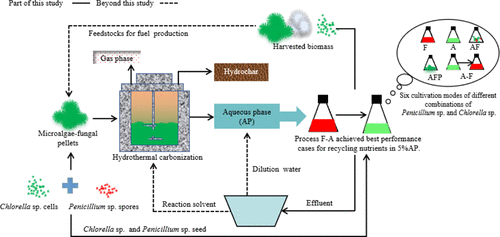当前位置:
X-MOL 学术
›
ACS Sustain. Chem. Eng.
›
论文详情
Our official English website, www.x-mol.net, welcomes your
feedback! (Note: you will need to create a separate account there.)
Hydrothermal Carbonization of Microalgae-Fungal Pellets: Removal of Nutrients from the Aqueous Phase Fungi and Microalgae Cultivation
ACS Sustainable Chemistry & Engineering ( IF 7.1 ) Pub Date : 2020-11-02 , DOI: 10.1021/acssuschemeng.0c05441 Jie Chen 1 , Lisha Ding 1 , Renfeng Liu 1 , Siyu Xu 1 , Luyi Li 1 , Liwei Gao 1 , Liang Wei 1 , Songqi Leng 1 , Jun Li 1 , Jingjing Li 1 , Lijian Leng 2 , Wenguang Zhou 1
ACS Sustainable Chemistry & Engineering ( IF 7.1 ) Pub Date : 2020-11-02 , DOI: 10.1021/acssuschemeng.0c05441 Jie Chen 1 , Lisha Ding 1 , Renfeng Liu 1 , Siyu Xu 1 , Luyi Li 1 , Liwei Gao 1 , Liang Wei 1 , Songqi Leng 1 , Jun Li 1 , Jingjing Li 1 , Lijian Leng 2 , Wenguang Zhou 1
Affiliation

|
Hydrothermal carbonization (HTC) has a unique advantage over conventional processes to convert wet biomass into a solid fuel without the need to dewater and dry the biomass. A byproduct of the HTC process is the aqueous phase (AP), rich in organic and inorganic compounds. The AP, if discharged without proper treatment, can cause environmental pollution. In this study, mono-, co-, and stepwise-culture of fungi (Penicillium sp.) and microalgae (Chlorella sp.) on AP from HTC of the same fungi-microalgae strains was investigated. The results showed that the stepwise culture for six days (first fungi and then microalgae cultivation) in 5% AP achieved a biomass yield of 0.63 g/L and the best performance for the removal of TN (32.91%), TP (95.30%), chemical oxygen demand (64.38%), NH4–N (26.97%), and organic components, probably due to the strong detoxification capability of the fungi, which improved microalgae growth. The microalgae and fungi biomass harvested from 5% AP can be sustainable feedstocks for fuel production. This study demonstrated that utilizing the AP for the cultivation of fungi and microalgae has the potential to form the semi-closed loop energy system in the biomass HTC approach.
中文翻译:

微藻-真菌颗粒的水热碳化:水相真菌中营养物的去除和微藻的培养
与将湿生物质转化为固体燃料而不需要对生物质进行脱水和干燥的传统工艺相比,水热碳化(HTC)具有独特的优势。HTC工艺的副产品是富含有机和无机化合物的水相(AP)。如果未经适当处理就将AP排放出去,可能会造成环境污染。在这项研究中,研究了在同一真菌-微藻菌株的HTC上的AP (真菌(Penicillium sp。))和微藻(Chlorella sp。)的单,共和逐步培养。结果表明,在5%AP中分步培养6天(先进行真菌然后进行微藻培养)可实现0.63 g / L的生物量产量,并且去除TN(32.91%),TP(95.30%)的性能最佳。 ,化学需氧量(64.38%),NH4 –N(26.97%)和有机成分,可能是由于真菌强大的解毒能力改善了微藻的生长。从5%的AP收集的微藻和真菌生物质可以作为燃料生产的可持续原料。这项研究表明,利用AP来培养真菌和微藻有可能在生物质HTC方法中形成半闭环能量系统。
更新日期:2020-11-16
中文翻译:

微藻-真菌颗粒的水热碳化:水相真菌中营养物的去除和微藻的培养
与将湿生物质转化为固体燃料而不需要对生物质进行脱水和干燥的传统工艺相比,水热碳化(HTC)具有独特的优势。HTC工艺的副产品是富含有机和无机化合物的水相(AP)。如果未经适当处理就将AP排放出去,可能会造成环境污染。在这项研究中,研究了在同一真菌-微藻菌株的HTC上的AP (真菌(Penicillium sp。))和微藻(Chlorella sp。)的单,共和逐步培养。结果表明,在5%AP中分步培养6天(先进行真菌然后进行微藻培养)可实现0.63 g / L的生物量产量,并且去除TN(32.91%),TP(95.30%)的性能最佳。 ,化学需氧量(64.38%),NH4 –N(26.97%)和有机成分,可能是由于真菌强大的解毒能力改善了微藻的生长。从5%的AP收集的微藻和真菌生物质可以作为燃料生产的可持续原料。这项研究表明,利用AP来培养真菌和微藻有可能在生物质HTC方法中形成半闭环能量系统。









































 京公网安备 11010802027423号
京公网安备 11010802027423号